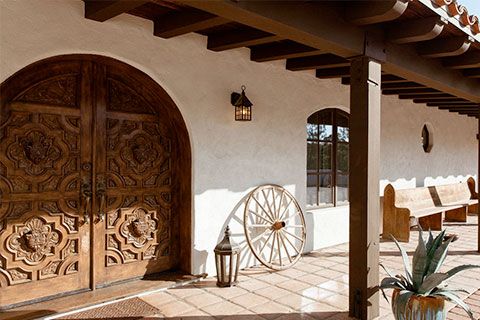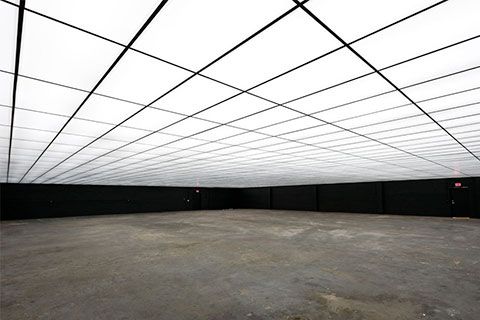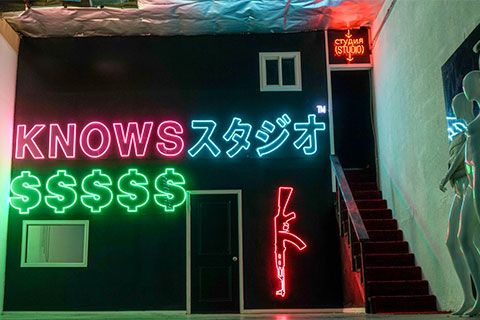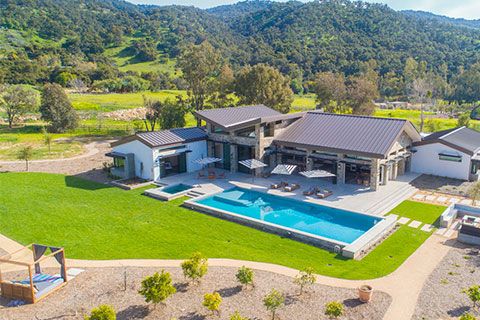The Ultimate Guide on How to Rent a Warehouse For A Day
Everything you need to know about renting warehouses for filming, photography and events.
For many Americans the decline of the US manufacturing industry is seen as a deeply negative phenomenon. Since its peak in June 1979, manufacturing employment in the US has declined by about 8.1 million leaving thousands of factories across the country sitting relatively empty. However, to say that these spaces are unused would be incorrect.
While the assembly lines are long gone, industrial spaces remain an important piece of the creative economy, providing an authentic backdrop for films, shows, photoshoots and commercials. In Los Angeles alone, there are over 500 warehouses currently available for filming, with industrial areas like downtown and East Los Angeles amongst the most popular film zones in the city. Since 2008 there have been over 30,000 productions in these two neighborhoods, with a majority happening in industrial or post-industrial spaces.

If you’re a content creator, the appeal of renting a warehouse for filming probably speaks for itself: high ceilings, wide views, varied textures, and a whole lot of personality. But what is probably less obvious, is what steps are required to actually rent a warehouse for a day. To make the learning process a little bit easier, we’ve put together this comprehensive guide based on our experiences coordinating hundreds of warehouse shoots.
Want to jump straight to finding your dream warehouse?
Search LocationsWe’ll cover how to conduct a location search, tips on budgeting, advice on permits, and a summary of features to expect when renting a warehouse for a day, a week or even longer. At the end of the guide we’ll also include a list of important questions to answer before renting a warehouse for filming, and links to some of the best warehouse locations in our library.
Rent a location for your next film or photo shoot project on Giggster – A better way to book locations.







Where can I find an affordable warehouse for rent?
First, do a quick search on Giggster for options in your price range and area. You should have at least a rough budget put together by now, so start your search with the money you already have set aside for locations (this amount should cover all location costs: rentals, permits and scouting).
Now you need to compare and contrast your options. The locations on your list should already achieve your desired aesthetic, so you want to compare each warehouse on additional criteria that’s critical to your production. Use three main points in your judgement.
1. Availability
a) Is the location available for your production dates?
b) If not, is the location valuable enough to change production dates?
2. Price
a) Does this location fit within the budget?
b) If not, can we use this space for additional location coverage that would justify spending additional dollars on it?
3. Amenities
a) Can this location offer resources needed for a successful shoot?
b) If not, are there facilities nearby that cover production needs?
You should be able to determine availability with relative ease. If you’re booking with Giggster, you’ll immediately see a location’s availability for your dates. If you’re cold calling warehouses in your area, the owners or building managers will provide that information up front. Price and amenities are the criteria that will really require some extra consideration.

How Much Does it Cost to Rent a Warehouse for Filming?
There is no average price for a warehouse rental. Day rates in major US cities typically range from $800 to $6,000 with prices that fluctuate by owner, location, time of year, and market demand. You may not think of South Carolina as a production hub, but even the Palmetto State advertises a wide range, claiming its property homeowners have collected between $100 and $20,000 per day.
Rural areas and less film-centric locations will tip the range lower, but if you’re in a metropolitan area, it’s reasonable to assume that you will need to spend at least $1,000 to rent a warehouse for a day after all of your costs are factored into it. That might seem expensive, but at least you’re not building the set for Titanic. Producers spent $40 million just on the water tank that housed the ship.
While you can always try to haggle to keep this price down, for the most part, the listed rate is what you’re going to pay when it comes to warehouse filming locations. Here at Giggster, we’ve seen just about every type of pitch imaginable, including a long list of exchange-based offers ranging from producer credit, guest parts, Instagram mentions, and even access to a personal timeshare in Indonesia. From our experience, 99.9% of commercial location owners will demand cash payment.
While cameras can be borrowed and people will work for credit – good film locations require cash.
It’s not uncommon for locations to stand out as the most expensive items in your line budget. In fact, locations and permits can easily account for 20-30% of a film’s total budget. Let’s set up an example of how 30% of your budget could look when spent on a warehouse location (even if you’re operating well below SAG’s definition of Ultra Low Budget– films under $250,000).

Location Budget Example
Let’s walk through how we might budget locations for a $12,000 fictional project. The first thing we’re going to want to do is break down the project down into thirds:
Pre-Production Costs: $2000
Production Costs: $6000
Post Production Costs: $4000
Assuming we follow a standard industry breakdown of spending 30% of your total budget on locations that would mean a budget of $3,600 for this $12,000 video. While this might seem like a lot of money, before you get searching cool spaces, you’re going to want to figure out how much of this $3,600 needs to be spent on permits.
How Much Do Film Permits Costs?
Film permits come down to what you’re doing, where, and for what reason. For example, a commercial shoot with drones in downtown LA will have vastly different permit requirements than an indie short film shot on a park bench in Branson, Missouri. The only way to determine what you need is by contacting the local office that handles film permits in your area (these people are almost always a part of an official Film Office or the local Parks & Recreation Department).
Permits in a city like Los Angeles or New York will cost more than a smaller city that’s less inundated with filming requests. Sometimes, it’s the number of permits you need in these metropolitan area that drive your total costs up.
Los Angeles, for example, lists more than 100 possible fees it can apply to any given production. Most of these fees won’t apply to you, but you still need to talk with someone in their film office to get official permission. If you’re in LA, estimate permit costs by emailing the LA film office with details of your shoot and your planned locations. You can email them at info@filmlainc.com and they aim to reply with fairly accurate estimates within 24 hours.
Update: Check out our Film Permits Explained article on the Giggster Blog for more guidance on the film permitting process in Los Angeles.
If you’re not in LA and your area doesn’t have a film office, reach out to your Parks & Recreation Department. If they can’t process the permits, they’ll know who you should contact.

Approximate Budget Breakdown
Project: Music Video
Budget: $12,000
Crew: 5-15 people
Location: Warehouse in El Sereno (shown here)
Location size: 2,001 sq. ft.
Shoot duration: 2 days
Warehouse booking cost: ~ $2,000
Warehouse permit cost: ~ $940 for Application ($685), Fire Inspection ($85), and Notification fees ($170)
Film LA says that $940 is their “lower estimate” for this example, so your production might incur added fees. Things like excess noise, pyrotechnics, or other special effects will drive the potential for additional permits (and therefore, price) up. Assuming your video won’t incur added permit costs though, you’re looking to spend around $2,940 for two days in your warehouse.
Congratulations, you landed well within your allotted 30%/$3,600 location budget and you have a little more than $600 left over for unforeseen costs such as parking tickets, or location damages.
Our example doesn’t translate perfectly across the country. For context, Austin, TX only requires filming permits in select cases. Even in these cases, the city doesn’t always require fees.
The best way to approach acquiring your permit is to be as detailed and transparent as possible when you talk to the Film Office or local government. Permits may not be the most exciting part of film work, but they have become a necessary requirement. Just remember, it’s considerably easier to handle potential issues with the local authorities before everyone is on set.

What Amenities Do I Need in a Warehouse Rental?
Don’t think of amenities as luxurious nice-to-haves. Your choice of production locations might come down to what they can offer your team vs. what you will have to supply yourselves. These common amenities will impact your shoot even if your team is small and your time on set is short.
a) Parking – Where will cast and crew park? Is it free? If no parking is available at the warehouse, are there options nearby? Most warehouses are located within active business districts. While most have parking lots for at least 20 cars, in some cases you will need to could mean trucks on streets, deliveries being made, and other forms of activity. Eight, twelve, or fifteen cars parked on the street could cause unwanted frustration and interference from neighboring businesses if you don’t scope out your options beforehand.
b) Bathrooms – Not every warehouse will provide adequate indoor facilities, so make sure yours has clean and functional bathrooms if you’re going to be there for more than a few hours. If none are available, find viable options that are close-by or look into providing some temporary options (Mr. John is a good option for the New York area).
c) Power/Electricity – Most likely, this cost will be included in the rental cost. Talk to the warehouse owner about outlets, make sure you have access to working electrical lines, and ask to be shown the breaker box if a location host or manager won’t be on set
d) Food – If you’re not providing it, are there reasonable food options near your location?
e) Air conditioning/Heat – Are you shooting in New York City in February or Los Angeles in August? Ask the host or owner about your warehouse’s insulation and find out if your shooting area is temperature controlled. If not, you will want to weigh the aesthetic value against the challenges of inclement shooting conditions.
d) Accessibility (for personnel and equipment)- You don’t need accessibility only to help those who can’t handle steps. Most warehouses will have relatively large entrances, but make sure your team and equipment can access these entrance points.
Maybe you want to channel the ending of Terminator and its amazing warehouse look. Go for it. Just make sure your warehouse has wide door frames and elevators in addition to those narrow stairs to make those great visuals possible.
Are There Legal Obligations for Renting a Warehouse?
Filming in a warehouse does not necessitate its own special legal coverage or insurance. However, the cost of production insurance pales in comparison to the potential cost of not having it. If you’re not insured already, now would be the time to look into it. Average annual costs range from the $400 to $2,500, but your price will depend on your size and what gets covered.
Do I Need Production Insurance?
Some companies specialize in Photography and Videography insurance, but other insurance providers may be able to offer you a tailored solution.
Start by contacting your existing insurance agent. They already have a relationship with you and they could be willing to write you a plan with custom long-term coverage, or create a short-term policy for your warehouse shoot. He or she may not be able to cover you, but you won’t know until you talk with them.
When you speak with an agent, ask them about a few of your most relevant options. Such as,
- General Liability Insurance
- Business Owner Insurance
- Professional Liability (Errors & Omissions) Insurance
- Workers Comp Insurance
The differences between these insurance policies can get confusing, so don’t hold back any questions when you talk to a specialist. You want to be sure you’re covering all your liabilities. For example, “General Liability Insurance” will cover most damages that can occur to the warehouse while you’re filming and it will cover harm/injury to people on set who are not working on the film. “Errors & Omissions Insurance” can cover you in the case of a dissatisfied client taking you to court over the final product. The only way to ensure that you’re adequately covered is by speaking with an agent and being clear about your needs.
How to Rent an Affordable Warehouse for your Next Project
Securing affordable production locations can be challenging, but don’t let that stop you from renting an amazing warehouse for your next project. They’re great spaces that offer you as many creative options as you can dream up. So go ahead, book that warehouse, and make something amazing. Trust us, your client is going to love you for it.
Good luck on your next shoot and remember to check out Giggster’s library of amazing locations. Your perfect warehouse is only a few clicks away.

